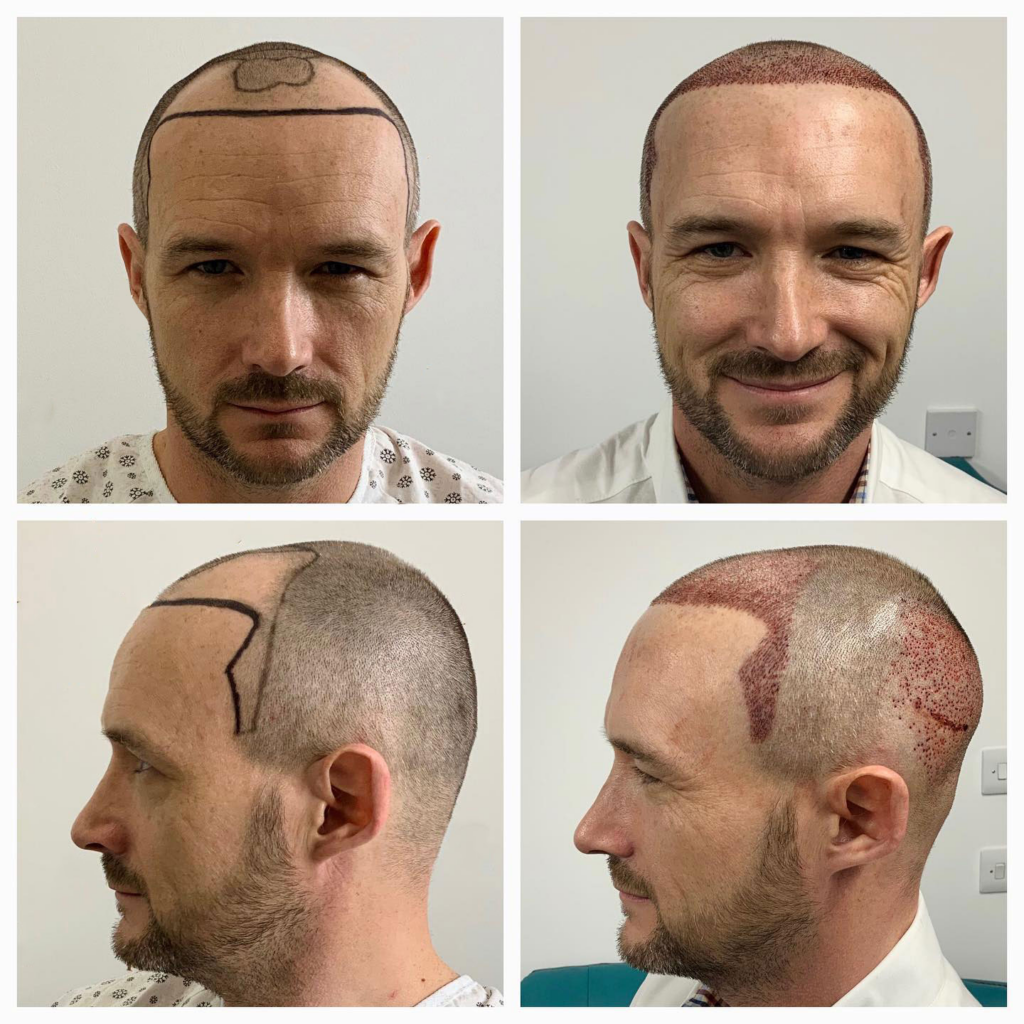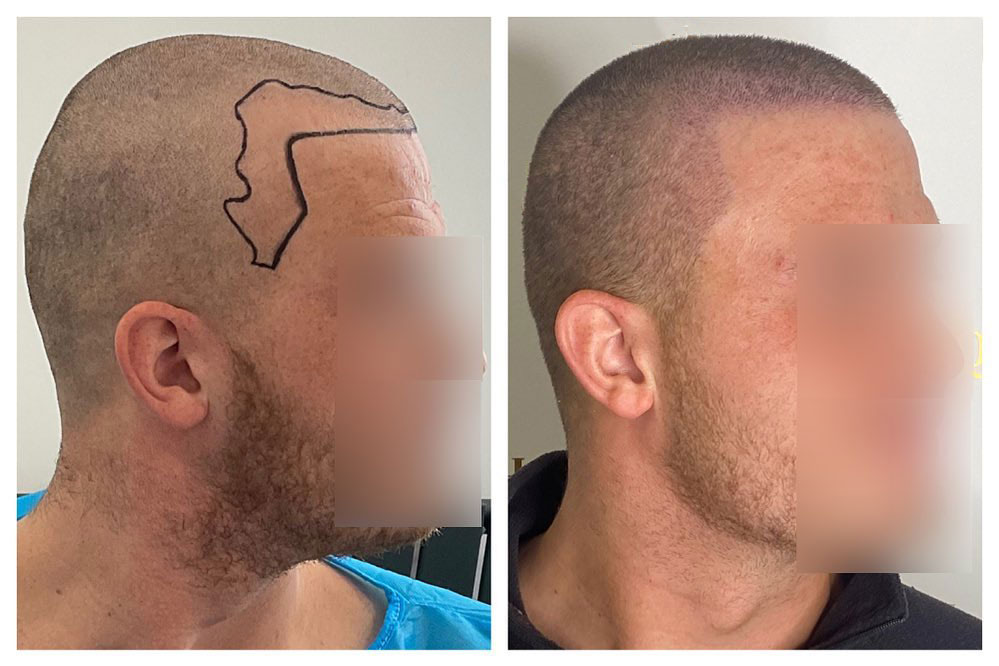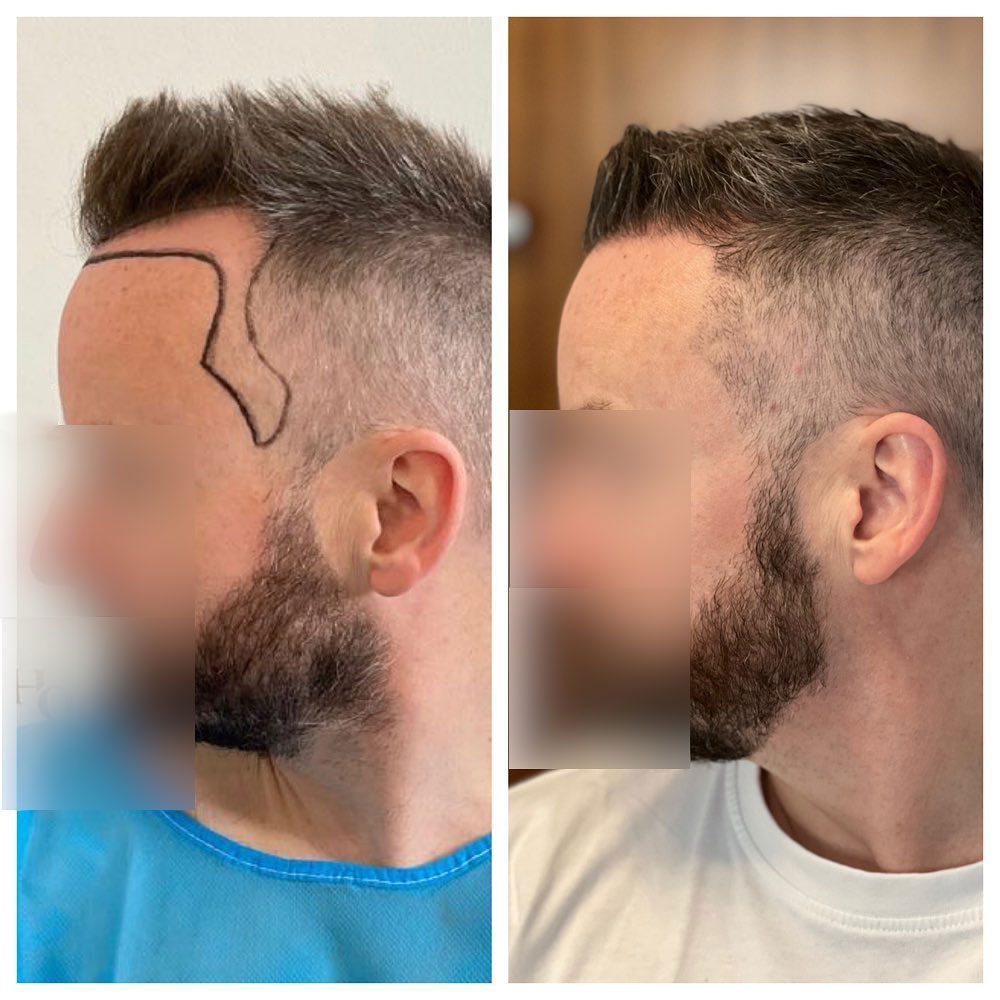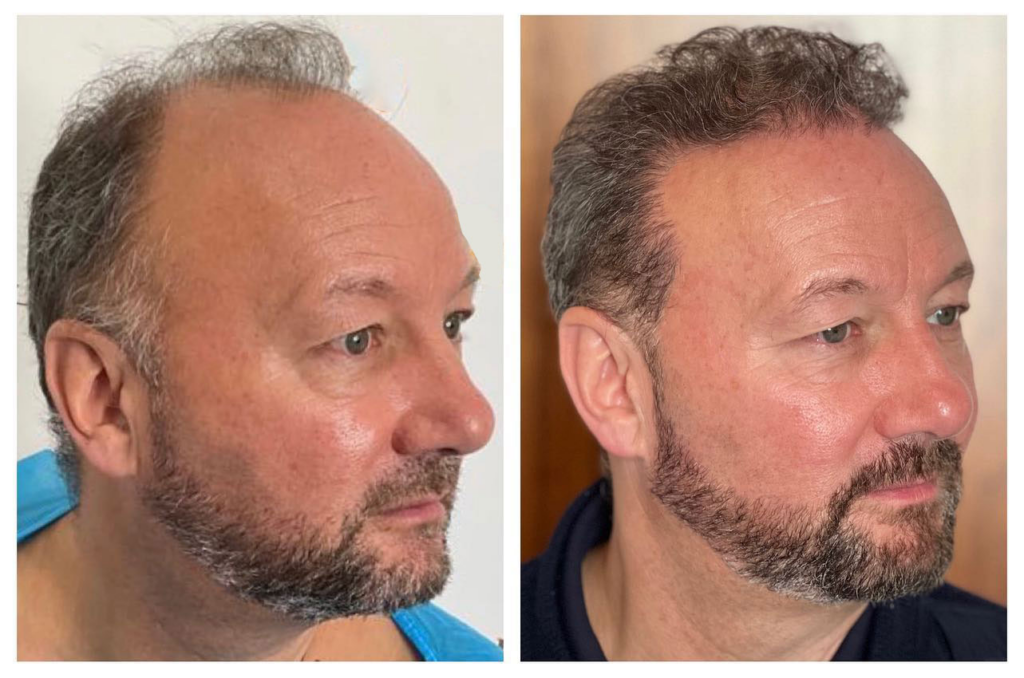Receding hairlines and thinning crowns are well-known signs of hair loss, but what about temple thinning? If your hair is starting to fade at the sides, it could be an early indicator of pattern baldness or androgenetic alopecia.
Not many hair transplant surgeons can restore temporal points that look completely natural, but Dr. Ted is one of the few who can. If you’re noticing hair loss on your temples, BOOK A CONSULTATION with Dr. Ted for expert temporal point restoration in Cardiff, UK.
What is Temple Hair Loss?
Temple hair loss refers to thinning or receding hair at the temples, the areas on the sides of your forehead where your hairline meets your face. It’s a common early sign of male and female pattern baldness. In men, it often starts with an M-shaped hairline that gradually moves back. In women, it can appear as subtle thinning that makes the hairline look less defined.
Losing hair at the temples isn’t just about genetics; it can also be triggered by stress, hormonal changes, or tight hairstyles that put a strain on the hairline. If you’re noticing some hair loss or thinning at your temples, you should seek treatment because it could be a sign of early balding.
What Causes Temple Hair Loss?
Hair loss on temples can be triggered by different hair loss conditions with androgenetic alopecia being the most common.
Androgenetic Alopecia
Androgenetic alopecia, aka male or female pattern baldness, is the most common cause of hair loss. It’s a hereditary condition that causes hair follicles to shrink over time due to sensitivity to dihydrotestosterone (DHT). As the follicles shrink, hair grows thinner, and weaker, and eventually stops growing altogether.
Temporal Triangular Alopecia
Temporal Triangular Alopecia (TTA) or congenital triangular alopecia, is a non-scarring type of hair loss that typically appears in childhood. It causes permanent hair loss in a triangular or oval-shaped patch on the scalp, usually at the temples. Unlike androgenetic alopecia, TTA is not caused by DHT or follicle miniaturization. Hair simply does not grow in the affected area.
Traction Alopecia
Repeatedly pulling your hair back into tight ponytails, buns, braids, or cornrows puts constant strain on the hairline. This can lead to traction alopecia, a form of hair loss caused by excessive tension on the follicles. Over time, this stress can weaken the hair at the temples and cause permanent damage if not addressed early.
Telogen Effluvium
Chronic stress and sudden traumatic events can push more hair follicles into the telogen (shedding) phase, a condition called telogen effluvium. This type of hair loss is often temporary, but it can make thinning at the temples more noticeable.
Hormonal Changes
Hormonal fluctuations can cause hair thinning, especially at the temples. Pregnancy, postpartum recovery, menopause, and thyroid disorders can all lead to temporary or long-term hair shedding. Polycystic ovary syndrome (PCOS), which is linked to higher levels of androgens, can also contribute to temple thinning in women.
Can Hair Grow Back on Temples?
It depends on the underlying cause. Temple hair loss isn’t always permanent, but regrowth is only possible if the hair follicles are still active. If the follicles have completely shut down due to conditions like advanced androgenetic alopecia, hair restoration treatments may be needed.
How to Fix Temple Hair Loss: Nonsurgical Options
Fixing temporal point hair loss depends on the cause and how advanced it is. If you catch it early, certain treatments can slow it down or even regrow hair. Here are clinically proven options you’ll want to consider.
Finasteride
Finasteride is one of the most widely used prescription treatments for male pattern baldness, including temporal point hair loss. It works by blocking dihydrotestosterone (DHT), the hormone responsible for shrinking hair follicles leading to premature hair thinning or loss.
By lowering DHT levels by about 70%, finasteride can stop further hair loss and, in some cases, help regrow hair at the temples. But it takes patience. Most people don’t see noticeable changes until three to six months in.
It’s important to note that finasteride only works as long as you keep taking it. Once you stop, hair loss resumes. Some men also experience side effects like a lower libido, but for many, the benefits outweigh the risks.
Dutasteride
Dutasteride is similar to finasteride but stronger. While finasteride blocks one of the two enzymes responsible for converting testosterone into DHT, dutasteride blocks both, reducing DHT levels by up to 90%.
That means it can be even more effective for those with aggressive hair loss, including temple thinning. Studies show it works better for regrowth, especially at the hairline, but it also comes with a slightly higher risk of side effects.
Unlike finasteride, dutasteride isn’t FDA-approved for hair loss, but many doctors prescribe it off-label for patients who need a more potent DHT blocker. Remember, though, both finasteride and dutasteride are not approved for use in women, especially those who are pregnant or may become pregnant.
Minoxidil
Minoxidil, known by the brand name Rogaine, is another popular temple hair loss treatment, but it works differently. Instead of blocking DHT, it increases blood flow to the scalp, keeping hair follicles in their growth phase longer.
If your temples are thinning but still have some hair, minoxidil can help thicken and strengthen those hairs. The downside is that it doesn’t work for completely bald areas, and if you stop using it, shedding can happen again.
However, when combined with finasteride or dutasteride, it can be an effective treatment for slowing hair loss and encouraging regrowth.
PRP for Hair Loss
If you’re looking for a non-medication approach, platelet-rich plasma (PRP) treatment for hair loss is another option. PRP therapy involves drawing a small amount of blood, processing it to extract growth factors, and injecting it into thinning areas.
PRP stimulates follicles, improves blood flow, and promotes healthier hair growth. It’s often used alongside other treatments like minoxidil or finasteride to enhance results. However, you’ll need multiple sessions and results vary from person to person. It works best in the early stages of hair loss when follicles are still active.
Permanent Temporal Point Restoration
A temporal point hair transplant is the only permanent solution for temple hair loss. But it’s also one of the most technically challenging procedures in hair restoration. Many hair surgeons avoid it altogether.
Temporal restoration requires a higher level of precision and artistry than transplanting the hairline or crown. If done incorrectly, it can create an unnatural look that gives away the transplant. This is exactly what experienced surgeons work hard to avoid.
Why Temporal Point Hair Transplants are Unique
Unlike the hairline or crown, the temporal points have a unique shape, angle, and density that make them difficult to replicate. The hair here grows at a much sharper, forward-facing angle, and if grafts are placed incorrectly, they will stand out instead of blending in.
Additionally, temporal hair is finer and more delicate than hair from other areas of the scalp, meaning the donor hair must be carefully selected to match the natural look.
Another challenge is long-term aesthetic balance. Many inexperienced surgeons will “fill in” the temples too aggressively to satisfy a patient’s request for a more youthful look. But overbuilding the temporal points can create an unnatural appearance, especially for Caucasian men who naturally have some recession in this area.
The goal of a well-planned transplant isn’t just to restore hair now. It’s to create a timeless result that will still look natural decades later, even as additional hair loss occurs.
Book Your Temple Point Restoration Consultation at Dr. Ted Hair Transplants.
Dr. Ted is one of the few hair transplant specialists with extensive experience in temporal point restoration that looks natural with no visible scars. He makes sure every hair is placed at the right angle and density so it looks like it’s always been there.
Call us to schedule your consultation today. We serve patients in and around Cardiff, UK, including Barry, Swansea, Newport, Gloucester, Cheltenham, Worcester, Bristol, Bath, Birmingham, Oxford, and London.
Temple Point Restoration Before and After Photos






